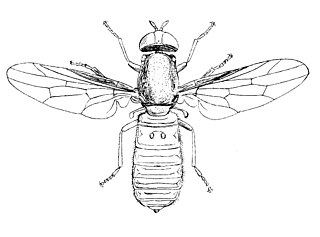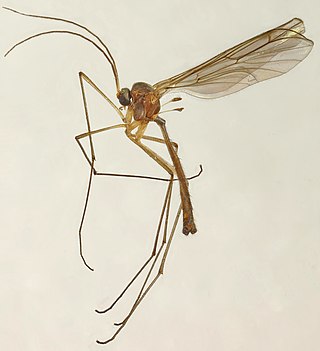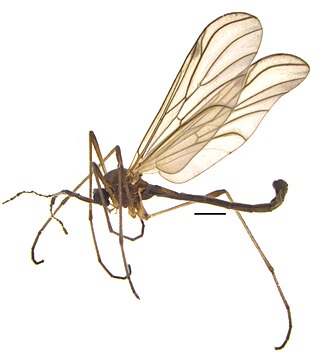
A crane fly is any member of the dipteran superfamily Tipuloidea, which contains the living families Cylindrotomidae, Limoniidae, Pediciidae and Tipulidae, as well as several extinct families. "Winter crane flies", members of the family Trichoceridae, are sufficiently different from the typical crane flies of Tipuloidea to be excluded from the superfamily Tipuloidea, and are placed as their sister group within Tipulomorpha.

The Tipulomorpha are an infraorder of Nematocera, containing the crane flies, a very large group, and allied families.

The Nematocera are a suborder of elongated flies with thin, segmented antennae and mostly aquatic larvae. This group is paraphyletic and contains all flies but species from suborder Brachycera, which includes more commonly known species such as the housefly or the common fruit fly. Families in Nematocera include mosquitoes, crane flies, gnats, black flies, and multiple families commonly known as midges. The Nematocera typically have fairly long, fine, finely-jointed antennae. In many species, such as most mosquitoes, the female antennae are more or less threadlike, but the males have spectacularly plumose antennae.
The Nymphomyiidae are a family of tiny (2 mm) slender, delicate flies (Diptera). Larvae are found among aquatic mosses in small, rapid streams in northern regions of the world, including northeastern North America, Japan, the Himalayas, and eastern Russia. Around a dozen extant species are known, with two fossil species found in amber, extending back to the Mid Cretaceous. Under an alternative classification, they are considered the only living representatives of a separate, suborder called Archidiptera which includes several Triassic fossil members. The family has characteristics associated with the Nematocera as well as the Brachycera. The antennae are shortened as in the Brachycera and these flies are long, having a snout with vestigeal mouthparts, non-differentiated abdominal segments with large cerci. The wings are narrow and hair-fringed and have very weak venation. They are known to form cloud-like swarms in summer and the short-lived non-feeding adults have wings that fracture at the base shortly after mating.

Dolichopodidae, the long-legged flies, are a large, cosmopolitan family of true flies with more than 7,000 described species in about 230 genera. The genus Dolichopus is the most speciose, with some 600 species.

Limoniidae is the largest of four crane fly families, with more than 10,700 species in more than 150 genera. Some studies have suggested it to be a paraphyletic group, with some limoniids being more closely related to Tipulidae and Cylindrotomidae than to other limoniids. Limoniid crane flies can usually be distinguished by the way the wings are held at rest. Limoniids usually hold/fold the wings along the back of the body, whereas other crane flies usually hold them out at right angles. Snow flies such as Chionea scita have no wings at all. Limoniids are also usually smaller than other crane flies, with some exceptions.

The Lauxaniidae are a family of acalyptrate flies. They generally are small flies with large compound eyes that often are brightly coloured in life, sometimes with characteristic horizontal stripes, such as in Cestrotus species. Many species have variegated patterns on their wings, but in contrast they generally do not have variegated bodies, except for genera such as Cestrotus, whose camouflage mimics lichens or the texture of granitic rocks.

Bibionidae is a family of flies (Diptera) containing approximately 650–700 species worldwide. Adults are nectar feeders and emerge in numbers in spring. Because of the likelihood of adults flies being found in copula, they have earned colloquial names such as "love bugs" or "honeymoon flies".

Diastatidae are a family of flies in the order Diptera. They are encountered primarily in the Holarctic Region, but several species are found in the Oriental, Neotropical and Australasian regions. Members of the family number over 20 described species in three genera. There is an additional fossil genus.

The Scenopinidae or window flies are a small family of flies (Diptera), distributed worldwide. In buildings, they are often taken at windows, hence the common name window flies.

The Tanypezidae, known as the “stretched-foot flies”, are small family of acalyptrate Diptera. The 28 species are found mostly in the New World, divided between two genera: Tanypeza is found in North America, with the type species extending into the Palaearctic, and Neotanypeza is neotropical in distribution and includes one species known only from Dominican amber from 17–20 million years ago, N. dominicana Lonsdale & Apigian. This distribution contrasts that of its sister family, the Strongylophthalmyiidae, which is mostly East Asian in distribution.
The Canthyloscelidae are a small family of midges closely related to the Scatopsidae.

Bolitophila is the sole living genus in the Bolitophilidae, a family of Diptera in the superfamily Sciaroidea, with around 40 Palaearctic and about 20 Nearctic species, and three species from the Oriental region (Taiwan). They are small (6–9 mm).

Pachygaster is a genus of flies in the family Stratiomyidae.

Brachystomatinae is a subfamily of flies belonging to the family Empididae.

Dolichopodinae is a subfamily of flies in the family Dolichopodidae.

Lygistorrhininae, commonly called long-beaked fungus gnats is a subfamily of flies in the Diptera family Keroplatidae. The groups was long treated as a separate family, but molecular phylogenetic analysis has shown it to belong to Keroplatidae. There are about 7 genera and at least 30 described species in Lygistorrhininae.
Axymyia is a genus of nematoceran flies in the family Axymyiidae. It contains only one described species, Axymyia furcata, from eastern North America. A second species, Axymyia japonicaIshida, 1953, is sometimes listed, but this species is now generally placed in the related genus Protaxymyia.

Hesperinus is a genus of flies and the sole genus in the relict family Hesperinidae belonging to the nematoceran infraorder Bibionomorpha. There are about 8 known species, nearly all from the Palaearctic region with one each from the Nearctic and Neotropical regions. Three fossil species from Eocene Baltic amber have been described. These flies have long 12-segmented antennae, legs and abdomen and males have well-developed wings while females have a short one. Little is known, but most species have been collected near streams in woodlands.
















